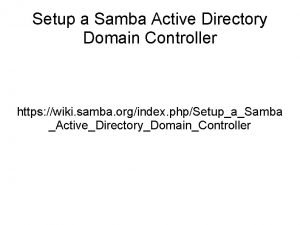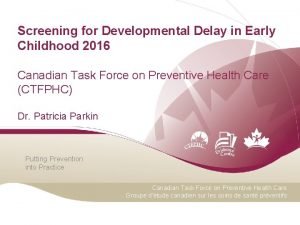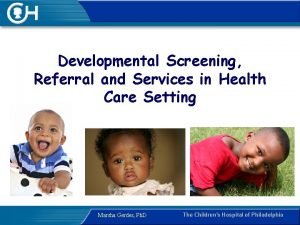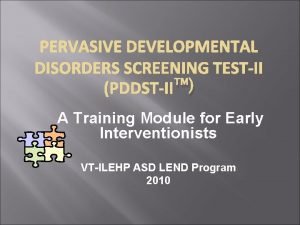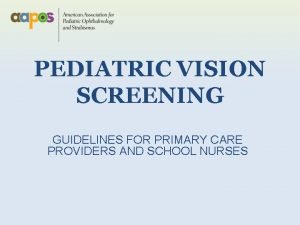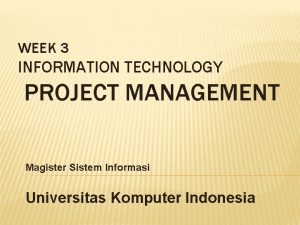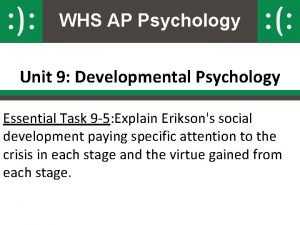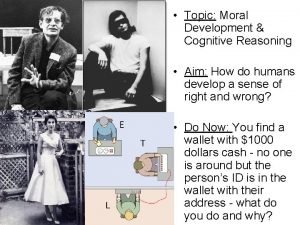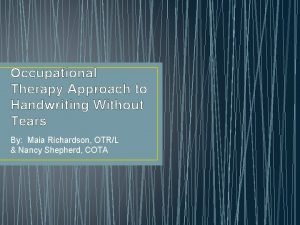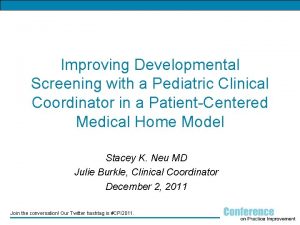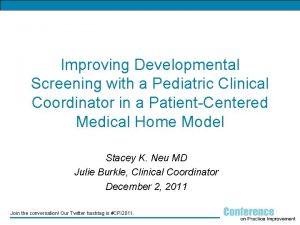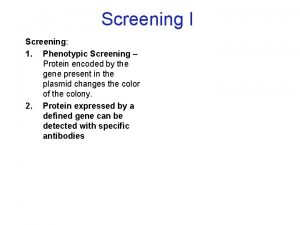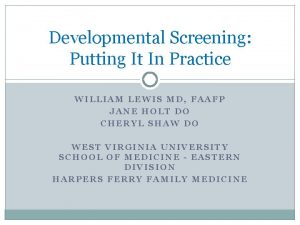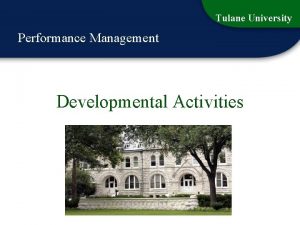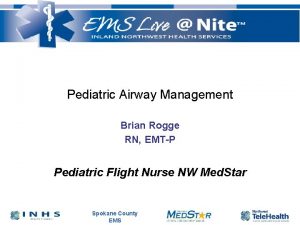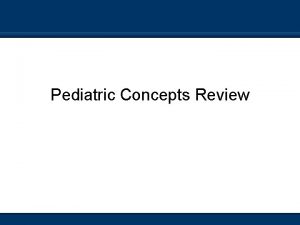Developmental Screening A Pediatric Practice HowTo Practice Management























- Slides: 23

Developmental Screening: A Pediatric Practice “How-To” Practice Management Association 2008 Teleconference Series Wednesday, October 29, 2008 12 noon Dr. Pippa Abston, MD, UAB Pediatrics (Huntsville) Janice Clark, Practice Manager, Anniston Pediatrics Renee Bringhurst, Blancher & Stadther in Mobile

Objectives To provide information on staffing, scheduling, and screening protocols necessary to implement developmental screening into your practices To identify generic and specialized community resources for families and children, birth to five years To learn the appropriate Medicaid and All-Kids reimbursement codes To learn appropriate methods to communicate with your parents on the benefits of the developmental screening tools

ABCD Screening Academy: National consortium Supports efforts of 18 states, District of Columbia, and Puerto Rico to implement policy and practice change Designed to move standardized developmental screening from best practice to standard of practice as part of well-child care 15 -month initiative that began in April 2007 (Alabama)

The American Academy of Pediatrics Policy Statement Recommends that: Developmental surveillance be performed at every preventive visit A screening tool should be administered at 9 -, 18 -, and 24 - or 30 -month visits and for those children whose surveillance yields concerns about delayed or disordered development --Demonstration project also included an additional screen at 4 years

What is Developmental Screening? NASHP defines developmental screening as the administration of a brief, standardized tool that aids the identification of children at risk of a developmental delay. Developmental Pediatrics Online adds that screening refers to the use of measures with proven reliability and validity that are administered in a standardized, i. e. , uniform, way. http: //www. dbpeds. org/articles/detail. cfm? Text. ID=139

A recent national survey found that just over half of parents say their child has ever had a developmental assessment during a pediatric visit. http: //www. cmwf. org

Importance of Early Intervention First 3 years of life are critical to brain development* Brain is most adaptable in childhood Early treatment is most effective for developmental conditions *Shonkoff JP, Phillips DA, eds. From Neurons to Neighborhoods: The Science of Early Childhood Development; 2000 ABCD Screening Academy Learning Session, July 2007. Sices, Lipkin, Earls

American Academy of Pediatrics: Developmental and Screening Algorithm

AABCD Practice Improvements Target Population (in terms of measurement) Medicaid eligible children, 0 – 5 years Increase in number of standardized screenings performed in accordance with AAP Periodicity Schedule at 9, 18, 24, and 48 months (e. g. , screenings increased from 95 to 410) Increase in referrals to appropriate services (e. g. , over a three-month period, referrals increased from 28 to 57) Another example: ALL Kids saw a 600% increase in 96110 billing claims

Measurable Outcomes: AABCD Demonstration Sites University of Alabama at Birmingham Health Center – Huntsville Regional Medical Center (Pediatric Department): Dr. Pippa Abston. University setting with residents and students. Anniston Pediatrics: Drs. Doggett and Vullaganti. Typical office setting. Blancher and Stadther, Mobile: Dr. Blancher is chair of the AL-AAP Children’s Mental Health Committee and is our State Physician Champion. Uses the ASQ Manager (EMR)

Pediatric Office Mechanics – UAB Pediatrics – Huntsville Held initial training with the office staff and pediatrician to introduce them to the ASQ Printed several age level copies of the ASQ test before office visits began Age-appropriate tote bags were assembled for parents Pediatric residents and students administered the ASQ to parents as part of routine exams

Pediatric Office Mechanics – UAB Pediatrics - Huntsville If no staff trainees or if service not covered by insurance, the parent filled out the ASQ prior to the pediatrician seeing the patient. Referrals to Early Intervention based upon results. Our practice used home stimulation handouts for parents to used as a teaching tool at home.

Pediatric Office Mechanics – Anniston Pediatrics Schedule ASQ (Ages and Stages Questionnaire) training with the DMH/MR Establish the age level of patients being screened Establish the appropriate coding within your practice Identify necessary resources in your area for easy referral

Pediatric Office Mechanics – Anniston Pediatrics A screening tool should be administered at 9 -, 18 -, and 24 - or 48 -month visits. Prepare patient charts one day in advance – place appropriate ASQ screening tool with the scoring sheet in individual patient charts. Upon arrival, the receptionist hands the form to the parent for completion while in the office. Patient is called to exam room and offered help from the nurse on completion of the form. Nurse scores the questionnaire (3 – 4 minutes in length) and places in the score sheet for the physician to review.

Pediatric Office Mechanics – Anniston Pediatrics Physician performs exam and discusses the ASQ results with the parent. If referral is indicated, the score sheet is marked “Referred, ” placed in the patient’s chart and moved to the nurse’s lab area (or an area where a nurse would usually follow up with patient’s needs). Our charge tickets were labeled “Refer to ______” and given to the referral clerk to make the appointment and follow up with the parent on necessary information.

Pediatric Office Mechanics -Blancher and Stadther (Mobile) Use the ASQ Manager (EMR). A dedicated office staff manages the ASQ forms and places them in the patient folders. ASQ is sorted by pediatrician and day of visit. Parent is given the test, explanation, and assistance if necessary to fill while at the office visit. n n Giving the ASQ to the well child parent to fill out allows for the pediatrician to tend to sick children. 10 to 15 minutes for the parent to complete the form and 3 minutes for the nurse or aide to score the test.

Pediatric Office Mechanics – Blancher and Stadther (Mobile) ASQ given at all well-child visits, but automatically at the 9 -, 18 -, 24 - and 48 -month check-ups. All Medicaid patients are included due to higher risk. Scores are logged in the developmental section of our EMR and a copy of the summary is scanned into the chart n n Pediatrician has the info in the chart to review prior to seeing the patient. Pediatrician will discuss the results of the test with the parent – inopportunity or developmental delay.

Pediatric Office Mechanics – Blancher and Stadther (Mobile) Inopportunity – given a copy of the age-appropriate activities from the ASQ manual Development Delay – parent linked to the Mobile county-wide referral resource list. Early Intervention is most widely used. n No ASQ for a severe delay such as Arthrogryposis. Maybe one for Down’s Syndrome to check for progress. Referral Request n n Form given to an office staff designated who will locate the resource, schedule and follow up with the parent Pediatrician will monitor for signs of improvement to report to the parent

Coding Protocol Medicaid – Physicians and physician-employed or Independent Nurse Practitioners, if enrolled as Medicaid EPSDT providers, may bill 96110. Nurse practitioners will be reimbursed at 80% of the physician allowed rate, which is $10. 00. In order to bill this code, a standardized developmental screening tool must be utilized. The policy for this code is in the January 2008 provider manual. A maximum of two tests is allowed. Documentation of the tool used, with interpretation and report, must be in the child’s medical record. ALL Kids - Will reimburse for up to four standardized screenings tied to a well-child visit during the first four years. Previously only paid 96110 with an abnormal code.

What is the ASQ? Ages and Stages Questionnaires (ASQ): a parentcompleted, child-monitoring system available from Brookes Publishing, www. agesandstages. com or 1 -800 -638 -3775, to screen infants and young children for developmental delays or concerns in the first five years of life Components include: n 19 questionnaires and corresponding scoring sheets n ASQ User’s Guide n CD-ROM and DVD availability n Ages and Stages Learning Activities n ASQ Manager, an easy-to-use computer database program for EHR practices

State Resources Child Find: Statewide program to locate, identify, and evaluate children with disabilities from birth to age 21. n Birth through 2: 1 -800 -543 -3098. n Ages 3 – 21: 1 -800 -392 -8020. Children’s Rehabilitation Service 1 -800 -846 -3697.

State Resources Patient 1 st Care Coordinators (Medicaid only) § Region 1: 256 -383 -1231 (Colbert, Franklin, Lauderdale, Marion, Walker, Winston) § Region 2: 256 -340 -2113 (Cullman, Jackson, Lawrence, Limestone, Madison, Marshall, Morgan) n Region 3: 205 -554 -4507 (Bibb, Fayette, Greene, Lamar, Pickens, Tuscaloosa) n Region 4: 205 -930 -1427 (Jefferson) n Region 5: 205 -274 -2120 (Blount, Cherokee, Dekalb, Etowah, Shelby, St. Clair) n Region 6: 256 -315 -4950 (Calhoun, Clay, Cleburne, Chambers, Coosa, Randolph, Talladega, Tallapoosa) n Region 7: 334 -877 -2828 (Choctaw, Dallas, Hale, Lowndes, Marengo, Perry, Sumter, Wilcox) n Region 8: 334 -361 -3759 (Autauga, Bullock, Chilton, Elmore, Lee, Macon, Montgomery, Russell) n Region 9: 251 -275 -4177 (Baldwin, Butler, Clarke, Conecuh, Covington, Escambia, Monroe, Washington) n Region 10: 334 -678 -2805 (Barbour, Crenshaw, Coffee, Dale, Geneva, Houston, Henry, Pike) n Region 11: 251 -690 -8980 (Mobile)

State Resources AL-AAP/AABCD Pediatric Resource Toolkit: http: //www. alchapaap. org/iform. asp? id=306 Alice Widgeon, Coordinator of Early Intervention Services Office of Children's Services, ADMH/MR P. O. Box 301410, Suite 504 Montgomery, AL 36130 -1410 Phone: 334 -242 -3702 Fax: 334 -353 -7062 Early Intervention: n Huntsville: 1 -800 -283 -9352 n Birmingham: 1 -888 -430 -7423 n Talladega: 1 -800 -947 -7140 n Montgomery: 1 -800 -441 -7607 n Dothan: 1 -800 -677 -9123 n Mobile: 1 -800 -879 -8163 n Tuscaloosa: 1 -800 -723 -0490
 Calculate gdp
Calculate gdp Samba 4 pdc
Samba 4 pdc Denver developmental screening test
Denver developmental screening test Developmental screening vs surveillance
Developmental screening vs surveillance Trivandrum developmental screening chart
Trivandrum developmental screening chart Trivandrum developmental screening test
Trivandrum developmental screening test Pddst
Pddst Iap ug teaching
Iap ug teaching Aapos vision screening app
Aapos vision screening app Project selection and portfolio management
Project selection and portfolio management Magister project management
Magister project management Initiative vs guilt
Initiative vs guilt Lawrence kohlberg developmental psychology
Lawrence kohlberg developmental psychology Theories of child psychology
Theories of child psychology Developmental homologies
Developmental homologies Glickman's developmental supervision model
Glickman's developmental supervision model Chapter 6 the adolescent in society
Chapter 6 the adolescent in society Developmental milestones بالعربي
Developmental milestones بالعربي Maslow stages of development
Maslow stages of development Blank 4856
Blank 4856 Research methods in developmental psychology
Research methods in developmental psychology Handwriting without tears developmental teaching order
Handwriting without tears developmental teaching order Developmental anatomy
Developmental anatomy History of developmental ideas in psychology
History of developmental ideas in psychology

